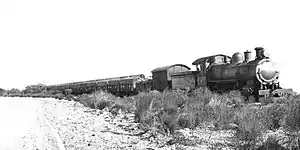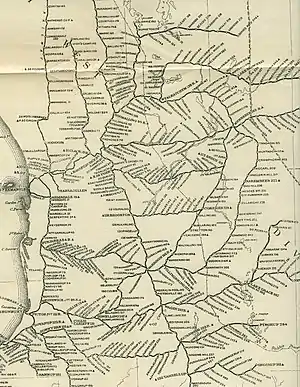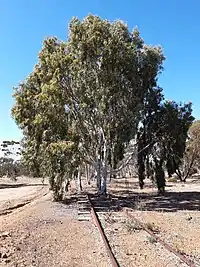Wheatbelt railway lines of Western Australia
The wheatbelt railway lines of Western Australia were, in most cases, a network of railway lines in Western Australia that primarily served the Wheatbelt region.

Maps of the Western Australian Government Railways (WAGR) system in the 1930s show that in the main wheatbelt region, any railway line was within 48 kilometres (30 mi) of the harvest location, facilitating ease of access to rail transport. Most of the larger extent of the network has since been closed.
In the current railway management systems, many of the remaining operating lines are primarily for the haulage of grain.[1]
1900s
In 1905 the report of the Royal Commission into Immigration in Western Australia[2][3] stated:
All considerable areas of agricultural land must have a 15 mile rail service
In 1947, the Royal Commission into Railway management[4] stated of the 1905 and after era of construction:
... to construct railways in agricultural areas as cheaply as possible, lines were built with 45 lb. rail sections which practically followed the surface of the ground with (a) earth ballasting (b) half-round timber sleepers (c) providing the bare minimum station facilities only
1930s

Transport of wheat on the WAGR system was identified by station/siding early in annual reports, as a commodity of importance to the railways.[5]
Early transport of grain was organised through the railways and growers with the Cooperative Wheat Pool of Western Australia as a main player.
The feasibility of bulk handling and storage, and the relationship with the railway networks then in place, was a concern of Westralian Farmers in the 1930s,[6] as well as that of the Western Australian government of the time.[7]
In 1932, five sidings in the Western Australian Government Railway System were the first locations of bulk handling of wheat by rail:[8]
- Benjaberring
- Korrelocking
- Nembudding
- Trayning
- Yelbeni
From the time of creation of specific railway branches or sections, most railway lines in the era of the WAGR carried mixed services of freight, and passenger services.
1950s
A number of lines of considerable length were closed in 1957 in the larger railway system.[9][10]
However not that many lines closed as a result of the 1957 decisions in the actual wheatbelt region:[11]
- Boddington to Dwarda (1913-1957) and Dwarda to Narrogin (1926-1957)[12]
- Brookton to Corrigin railway (1915-1957)
- Gnowangerup to Ongerup (1913-1957)[13]
- Muckinbudin to Lake Brown (1923-1957) and Lake Brown to Bullfinch (1929-1957)[14]
- Nyabing to Pingrup (1923-1957)[15]
Following the decline of passenger services in the 1950s, many branch lines ceased to have specific passenger services and the WAGR road bus services replaced rail passenger facilities.
1970s
In the decade of the creation of the brand Westrail,[16][17] many branch lines had sidings removed, and had ceased to operate as mixed freight lines. They became in many cases oriented to single commodity lines; timber, woodchip, iron ore or grain haulage became the main orientation of many of the branch lines in the narrow gauge network.
Agreements
In the 1980s a range of agreements between the rail operator and CBH were reached.[18]
Current network
The current wheatbelt railway lines are linked to the extensive network of CBH grain receival points that are serviced by CBH Group[note 1] as part of the co-operative bulk handling business.[19]
CBH has invested in its own grain haulage rolling stock and locomotives. In 2012 it took delivery of the CBH class locomotives.
Tiers
The Western Australian Minister for Transport, Simon O'Brien, created the Freight and Logistics Council of WA in 2009,[20] composed of individuals involved in transport industries in Western Australia.[21] The Minister commissioned Strategic design + Development Pty Ltd, under the guidance of the Strategic Grain Network Committee (also appointed by the Minister), to conduct a study into the rail network serving the wheatbelt. A report was delivered in December 2009.[22] In the 2009 report, and the state government's response to it, the rail network has been identified as having "tiers" - the Tier 1 and Tier 2 grain haulage railway lines have been deemed to be essential to the operations of the grain freight network.[23] The position taken by the government recommended the closing of the Tier 3 railway lines[24] and developing the "Brookton Strategy", which involves CBH Group investing in rapid grain loading facilities at Brookton and Merredin.[25]
The Tier network is identified on the maps as the railway lines (Tier 2 and 3 as extensions beyond the main Tier 1 network) as following:
- Eastern Railway sections
- Kwinana to Avon (Northam) (Tier 2 extends to Miling, and McLevie)
- Northam to Merredin (Tier 3 Merredin to Kondinin)
- Northam to Kalannie (Tier 2 extends to Beacon)
- Northam to Koorda (Tier 2 extends to Mukinbudin)
- Merredin to Southern Cross
- Northern Railway sections
- Kwinana to Geraldton (via Moora and Mingenew)
- Geraldton to Mullewa
- Mullewa to Perenjori (Tier 2 extends to Latham)
- Southern Railway sections
- Northam to Wagin (Tier 3 to Quairading) (Tier 3 from Narrogin to Merredin) (Tier 3 from Narrogin to Kulin)
- Wagin to Lake Grace
- Lake Grace to Hyden
- Lake Grace to Newdegate
- Wagin to Albany (Tier 3 Katanning to Nyabing) (Tier 3 to Gnowangerup)
Closures

The government decided in 2012 to close the Tier 3 lines and upgrade local and state roads.[26]
Considerable concern was raised as to the closure proposals of the Tier 3 lines,[27] and the expected consequent increase in road traffic.[28]
The Wheatbelt Railway Retention Alliance[29] and the Save Grain on Rail website continued to state the case for retention of the network.[1]
In October 2012, the WA Treasurer Troy Buswell announced a delay in closure of the Tier 3 railway lines, and a move of the onus for upgrading onto the operators, and not for the government to fund or maintain.[30][31][32][33]
The January 2013 report by the West Australian Auditor General Colin Murphy was critical of the Public Transport Authority and its management of the rail freight network lease.[34][35][36]
In early 2013, the Western Australian state election campaign saw increased activity in relation to the issue.
The Wheatbelt Railway Retention Alliance[37] and The West Australian reproduced the map of WA's grain rail network, outlining the context of the three tiers of the rail network.[38]
In September 2013, Buswell repeated his lack of interest in supporting the Tier 3 network, by responding to an issue on the Quairading line.[39]
In October 2013 Brookfield Rail announced closure of two of the Tier 3 railway lines (Merredin-Trayning and York-Quairading), with others not decided upon.[40][41]
The remaining Tier 3 lines were closed in June 2014.[42]
Arc Infrastructure
In July 2017, Brookfield Rail changed its name to Arc Infrastructure.
Over three years of drawn out mediation and arbitration was carried out between Brookfield/Arc and CBH.[43][44]
Despite the time and negotiation of a rail access agreement, over 500 kilometres (310 mi) of tier three railways remained closed.[45][46]
November 2019
On 1 November 2019, an agreement was finalised between Arc Infrastructure and CBH, after over seven years of actions and negotiations.[47] The agreement involved keeping the Miling railway line open, and all other tier 3 railways closed, and allowing CBH access until 2026.[48][49][50][51][52]
See also
| Wikimedia Commons has media related to Wheatbelt railways of Western Australia. |
Notes
- In current CBH terminology known as Receival locations, known colloquially and earlier as the "bins"
References
- "About the rail network". Save Grain on Rail. Archived from the original on 14 January 2013.
90-95% of Wheatbelt Grain transported on Rail
- Western Australia. Royal Commission on Immigration (1905), Report of the Royal Commission on Immigration together with appendices and minutes of evidence, Govt. Printer, retrieved 3 July 2015
- "The Immigration Commission". Kalgoorlie Miner. Western Australia. 14 August 1905. p. 4. Retrieved 3 July 2015 – via National Library of Australia.
- Royal Commission Appointed to Inquire into the Management, workings and control of the Western Australian Government Railways; Gibson, Alexander J.; Du Plessis, D.H.C. (1947), Report of the Royal Commission appointed to inquire into the Western Australian Government Railways, Govt. Pr, retrieved 3 July 2015
- Western Australian Government Railways Commission (1900), Report on the working of the government railways for the year ended 30th June, Govt. Printer, retrieved 4 October 2013 - usually in appendices to the report that identify goods carried by the railways
- Trustees of the Wheat Pool of Western Australia (1932), Report to Trustees of the Wheat Pool of Western Australia on feasibility of bulk handling of wheat, the various types of storage bins considered, needed alterations to railway tracks, sidings etc proposed by Westralian Farmers Ltd, retrieved 18 October 2012
- Western Australia. Royal Commission on the Bulk Handling of Wheat; Angwin, William Charles; Mitchell, James, Sir (1935), The Bulk Handling of Wheat Royal Commission: report to His Excellency Sir James Mitchell, Govt. Printer, retrieved 18 October 2012
- WAGR Annual report 1932
- Royal Commission on the Western Australian Government Railways; Smith, A.G. (1959), Interim report no. 9 of the Royal Commission on the Western Australian Government Railways, retrieved 25 February 2019
- "AU WA A658 - ROYAL COMMISSION TO ENQUIRE INTO AND REPORT UPON THE ADMINISTRATION OF GOVERNMENT RAILWAYS IN WA". State Records of Western Australia.
- Quinlan, Howard; Newland, John R.; Australian Railway Historical Society. New South Wales Division (2000), Australian railway routes 1854 to 2000 (1st ed.), Australian Railway Historical Society - New South Wales Division, pp. 64–72, ISBN 978-0-909650-49-0 - narrow gauge lines of Western Australia
- Opening of the Narrogin-Dwarda Railway in Narrogin, September 1926, 1926, retrieved 26 February 2019
- "TAMBELLUP- GNOWANGERUP-ONGERUP RAILWAY". Gnowangerup Times. 1 (44). Western Australia. 26 July 1913. p. 2. Retrieved 26 February 2019 – via National Library of Australia.
- "RAILWAY OPENING". The Southern Cross Times. VI (426). Western Australia. 24 August 1929. p. 6. Retrieved 26 February 2019 – via National Library of Australia.
- "NYABING TO PINGRUP". The West Australian. XXXIX (6, 686). Western Australia. 29 October 1923. p. 6. Retrieved 26 February 2019 – via National Library of Australia.
- Western Australian Government Railways Commission (1981), Westrail, a concise history (Reprinted and rev ed.), W.C. Brown, Govt. Printer, retrieved 18 October 2012
- Affleck, Fred N.; Clark, Bill; Western Australian Government Railways Commission (1978), On track: the making of Westrail, 1950 to 1976, Westrail, ISBN 978-0-7244-7560-5
- Westrail; Co-operative Bulk Handling Limited (1987), Review of operational understanding between Westrail & CBH for 1987. Report on the working of the compromise plan, Westrail, retrieved 24 July 2017
- Co-operative Bulk Handling Limited (1992), CBH: a profile, Co-operative Bulk Handling, retrieved 12 October 2012
- "About the Council". Freight and Logistics Council of Western Australia. Archived from the original on 15 April 2013.
- "Membership". Freight and Logistics Council of Western Australia. Archived from the original on 15 April 2013.
- "Report prepared for Freight and Logistics Council of WA on behalf of the Strategic Grain Network Committee" (PDF). Strategic design + Development Pty Ltd. December 2009. Archived from the original (PDF) on 1 April 2012. Retrieved 21 April 2013.
- "Grain Rail Network Upgrade". Archived from the original on 12 December 2012. Retrieved 12 October 2012.
State and Federal government funding announced in November 2010 and January 2011 respectively, underwrites the $164.5 million Tier 1 and 2 narrow gauge grain rail re-sleepering program, which will see around 1,265 kilometres of rail lines dedicated to grain freight re-sleepered over the next four years
- "Tier 3 Rail Lines". The Western Australian Farmers Federation. 13 October 2011. Archived from the original on 13 November 2011. Noting that the WA Farmers Federation clarify their arguments against the recommendations
- Hinkley, Bobbie (4 August 2011). "End of the line for Tier 3 says Buswell". Farm Weekly. Archived from the original on 21 September 2011.
- Varischetti, Belinda (23 August 2012). "Wheatbelt calls on WA Nationals to stand up and fight for tier three rail". Australian Broadcasting Corporation. Retrieved 23 April 2013.
- Varischetti, Belinda; Grieve, Owen (22 August 2012). "Wheatbelt determined to fight State Government decision to close tier three rail lines". ABC Rural. Archived from the original on 24 August 2012.
- "Rail line closures to lead to spike in truck numbers". WA Today. 22 August 2012.
- Clapin, Tom (6 April 2012). "York rail meeting builds on alliance momentum". Farm Weekly. Archived from the original on 9 April 2012.
- https://archive.today/20121126235100/http://www.mediastatements.wa.gov.au/Lists/Statements/DispForm.aspx?ID=151170. Archived from the original on 26 November 2012. Missing or empty
|title=(help) - "Tier 3 rail network to remain open". ABC News. 11 October 2012.
- "Buswell backflips on rail closure". Business News Western Australia. 11 October 2012.
- "Tier 3 lines to stay open in WA". Farming Ahead Online. 12 October 2012. Archived from the original on 31 October 2013.
- "Management of the Rail Freight Network Lease: 12 Years down the Track". ABC News. 3 January 2013.
- PSnews https://archive.today/20130403204101/http://wa.psnews.com.au/Page_WApsn1675.html. Archived from the original on 3 April 2013. Missing or empty
|title=(help) - Acott, Kent (3 January 2013). "Funding needed for rail freight: report". The West Australian – via Yahoo! News.
- "Membership". Save Grain on Rail. Archived from the original on 9 April 2013. Retrieved 21 April 2013.
- "Tier 3 may derail WA election". The West Australian. 19 February 2013. p. 2. Archived from the original on 30 October 2013 – via Yahoo! News.
- Thompson, Brad (25 September 2013). "Buswell washes hands of Tier 3". The West Australian – via Yahoo! News.
- "Wheatbelt farmers concerned rail freight line closure will hit their back pockets". ABC News. 3 October 2013.
- Thompson, Brad (3 October 2013). "Wheatbelt rail lines to close". The West Australian. Archived from the original on 5 October 2013 – via Yahoo! News.
- Thompson, Brad (1 November 2014). "Nalder snared in train wreck". The Weekend West. p. 127.
- "More arbitrators for CBH rail access claim. (EARLY GENERAL NEWS)", Farm Weekly (Victoria Park, Australia), Fairfax Media Publications Pty Limited: 4, 20 August 2015, ISSN 1321-7526
- "CBH - CBH signs rail agreement extension -- 1/12/2016. (Media Releases)", Australia Grains, Acquisdata Pty Ltd: 3(1), 6 December 2016, retrieved 24 July 2017
- Australian Broadcasting Corporation. News (2 July 2014), WA farmers rally to keep grain lines open, Australian Broadcasting Corporation, retrieved 24 July 2017
- Dupe, Cally (20 July 2017). "Hark! Its an arc for WA Rail". the Countryman. p. 9. "We've changed our name". the Countryman. 20 July 2017. p. 5.
- "No Tier 3 ... but it's not the end of the line, yet", Countryman, West Australia Newspapers Ltd: 2–3, 7 November 2019
- Hastie, Hamish (4 November 2019). "WA grain-train dispute over, but hopes of Tier 3 reopening derailed". Sydney Morning Herald.
- Mercer, Daniel (3 November 2019). "Standoff between CBH and Arc ends in breakthrough grain rail freight deal". ABC News.
- Thompson, Brad (4 November 2019). "Farmers want tougher oversight after six-year rail war". Financial Review.
- Gill, Mal (7 November 2019). "CBH, Arc rail deal on track". Farm Weekly.
- Demaree-Saddler, Holly (11 April 2019). "CBH secures Western Australia access to grain rail network". World-Grain.com.
.JPG.webp)